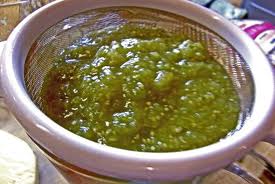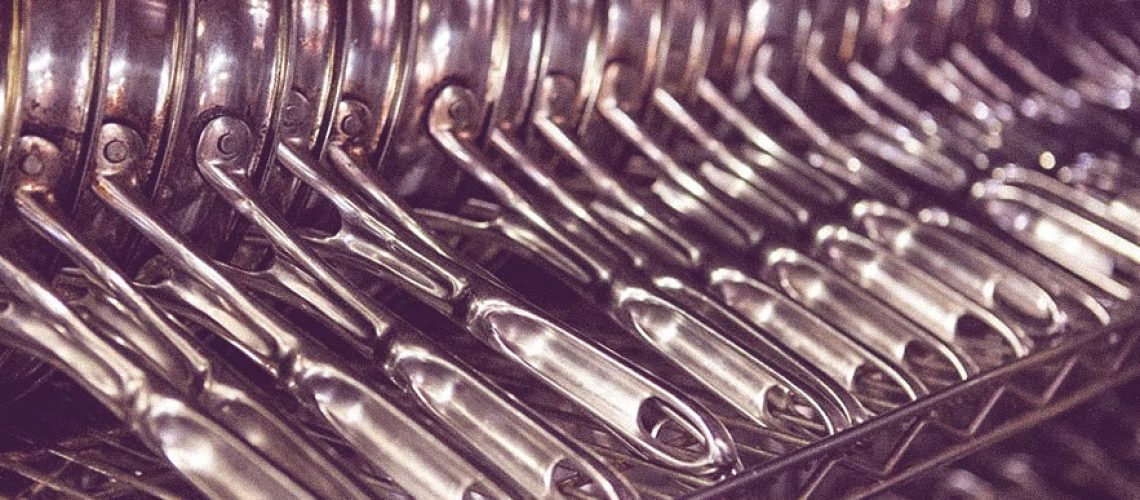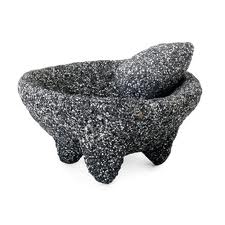 Green Sauces are common in Mexican and Mexican-American cuisines. The  basis of the green sauce (known as Salsa Verde) is typically pureed cooked or raw tomatillos, with chiles or jalapenos, white onion, cilantro and sometimes lime to taste. Salsa Verde can range in spiciness from mild to mouth-searing. It may be warm as in chile verde, or cold, as a condiment. In Mexican-American cuisine, a green sauce is frequently used as a dip for tortilla hips and served with tacos, grilled pork, grilled meats and even fish.
Green Sauces are common in Mexican and Mexican-American cuisines. The  basis of the green sauce (known as Salsa Verde) is typically pureed cooked or raw tomatillos, with chiles or jalapenos, white onion, cilantro and sometimes lime to taste. Salsa Verde can range in spiciness from mild to mouth-searing. It may be warm as in chile verde, or cold, as a condiment. In Mexican-American cuisine, a green sauce is frequently used as a dip for tortilla hips and served with tacos, grilled pork, grilled meats and even fish.
Green Sauce
- 1 quart water
- 12 whole tomatillos
- 1 medium clove garlic, whole
- 2 round tip jalapenos(vary according to preference for piquancy)
- 3 tablespoons, white onion, coursely chopped
- 3/4 cup cilantro leaves, with a bit of stem
- Salt to taste
For the Garnish
- 1/4 cup white onion, chopped
- 1/4 cup cilantro, chopped
Bring the water to boil in a saucepan. Add tomatillos, garlic clove, t or more chiles and onion.Cook over medium heat for 20 minutes and remove from heat. Drain and reserve cooking water. Cool. Meanwhile, puree garlic clove to a molcajete or food processor, adding salt to taste. Add cilantro and blend Add tomatillo mixture. Add a little cooking water and blend. The sauce should have a slightly thick consistency. Correct seasonings. To serve, pour green sauce into a molcajete (or other cool dish) and garnish with onion and cilantro.
What’s a molcajete?
Molcajetes are used to crush and grind  spices,and prepare salsas, and guacamole. The rough surface of the basalt stone creates a superb grinding surface that maintains itself over time as tiny bubbles in the basalt are ground down, replenishing the textured surface. As the porous basalt is impossible to fully clean and sanitize, molcajetes are known to “season” (much like cast iron skillets), carrying over flavors from one preparation to another. Salsas and guacamole prepared in molcajetes are known to have a distinctive texture, and some also carry a subtle difference in flavor, from those prepared in blenders. Molcajetes can also be used as a cooking tool, where it is heated to a high temperature using an open fire or hot coals, and then used to heat its food contents. Although true molcajetes are made of basalt, imitations are sometimes made of a mixture of pressed concrete and volcanic rock particles.
Molcajetes are also used as serving dishes in restaurants and homes. While recipes are usually not stewed or otherwise cooked in them, the molcajete stays hot for an extremely long time, and it is not unusual for a dish to still be bubbling a half hour after serving.



